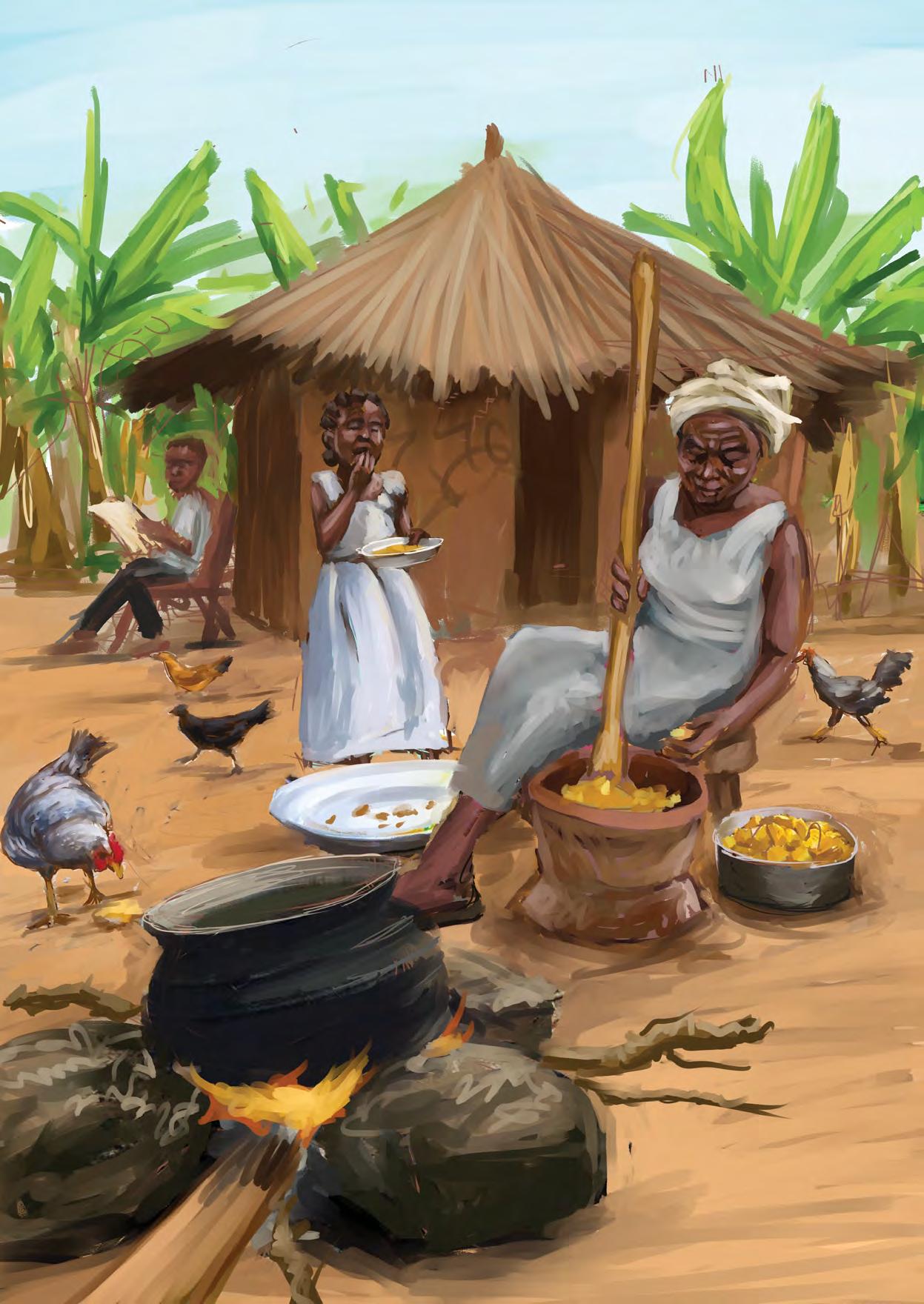
27 minute read
Insects, wild foods, fermentation and Budja Hearths
7 Insects, wild foods, fermentation and Budja Hearths

Advertisement
“Fanza, I’ve just received this great story from a community worker in Zimbabwe about a local organisation that’s actively promoting and reviving traditional recipes in local communities in many creative ways. It started as a response to the HIV/AIDS pandemic. What’s your task this time around?”
“Monica suggested I investigate how the COVID-19 pandemic, which has broken global supply chains, may have changed where communities get their food from and even the kind of food they eat. I am still looking. Why don’t you read me your story, Abdou?”
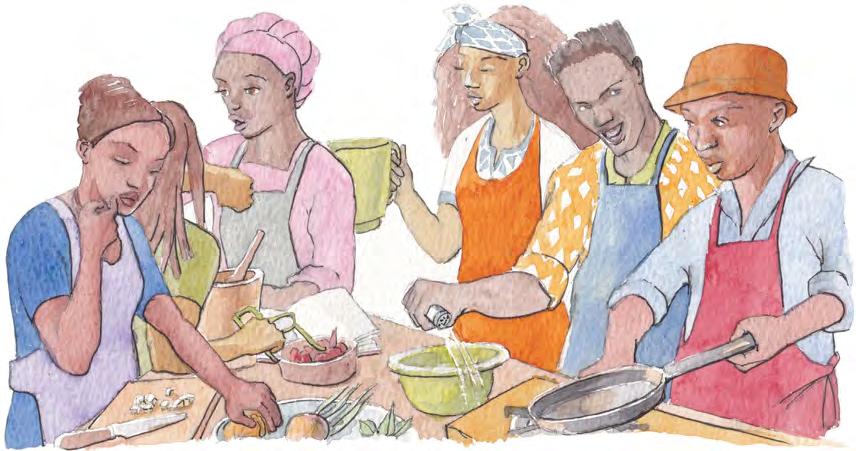
Reviving the Budja Hearth, an indigenous kitchen of Zimbabwe
by Romeo Chingezi
“Some of our grandmothers still know how to cook proper food!” the one chief reminded us. “Yesterday we had a feast with goat stew, okra, nhopi, forest mushrooms, fried caterpillars, cowpea fritters and mabumbe! Why do you think I am in such a good mood today?”
Everyone laughed, not only at the good humour of the elder but because of the joyful anticipation of what we had gathered to do. This was the first meeting of a key committee started at village level in the Mutoko District of Mashonaland East, Zimbabwe in 2007. It was called to revive traditional food and cooking as an immune-boosting and healing response to the HIV/AIDS pandemic.
The recipe book is born
After some discussion we agreed that the first thing was to produce a traditional recipe book. Soon we were seeking out the knowledge about traditional foods from different individuals within the community. The recipe book was produced and spread to the communities and even sold widely. Everyone loved the idea and praised the recipes. We started cooking demonstrations and educational dramas within the community, training quite a number of people. This helped to spread the recipes and the practice across the country.
Much to our surprise the initiative started to gain recognition from the local government in our district, and then the Food and Nutrition Security Council and even from the Minister of Agriculture. We received invitations to participate in annual food festivals and culture weeks. We were the flavour of the month!
This is the early story of the Svinurai Arts Association in Zimbabwe. Founded by Helen Agnes Zhinhu and Fungai Karimazondo, this group celebrates culture through delicious traditional recipes, spreading a message of health and hope through drama and good cooking. We wanted to help people to restore their own traditional knowledge about healthy eating and lifestyles and to end the stigma around HIV/AIDS disease. Many people were under the impression that eating healthily meant going to a hotel or luxury restaurant to eat some of those expensive meals, hardly realising that they could get even better nutrition from local traditional foods.
The Budja Hearth is born
The organisation grew and its influence expanded into other Municipal Wards of the District. We then decided to establish a centre in their Ward and built a very beautiful Budja hearth, an indigenous type of a kitchen to which we would invite women from neighbouring communities to train them on how to prepare the traditional meals and to understand and value of indigenous foods. The idea is for all households to see how their own traditional Budja Hearths can produce healthy food for their families.
Protecting forests and mitigating climate change
During the cooking lessons at the Budja Hearth the participants were taken into the bush and forest to collect wild varieties of foods and store them in the kitchen. This taught them how important it is to protect the forests.
Since then, we have begun working with our local communities to make them more aware about what needs to be done to prevent deforestation, as rural communities depend on the forests as their source of fuel.
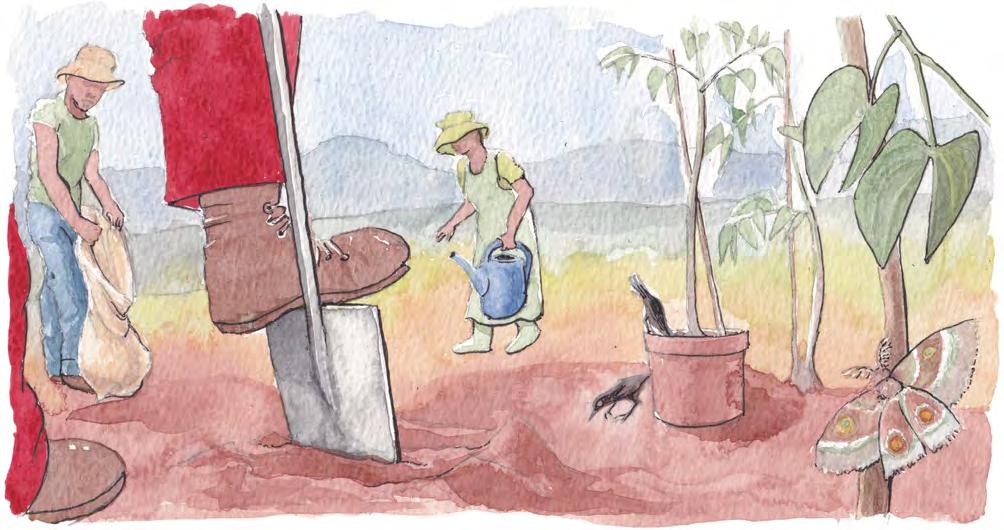
To minimise the use of wood we have begun to promote the Total Stove for people to use in their Budja Hearths. The Total Stove is built using a few bricks designed so that instead of using lots of firewood you can use small branches from pruning a tree. The Total Stove burns them more efficiently, and the trees stay alive. Simple and sustainable!
We are also encouraging people to plant trees. As a result, there’s an increase in the number of trees planted around their homesteads, including fruit trees.
Still going strong
The Svinurai Arts Association continues to be active in farming and growing crops, as well as cooking and producing dramas. These highlight different social issues and encourage self-reliance projects especially for widows. They also inform communities about health issues like HIV/Aids and Tuberculosis. We also visit schools and work on empowering children to help prevent child abuse and to encourage them to know and appreciate their indigenous culture.
The recipe book is sold to those who can afford it and given free to community members who cannot.
We also showcase their work in the cities at festivals and other events to promote traditional food and their messages of hope and health. Sometimes we offer catering services but always make sure that we include a short educational drama and talk before the meal starts!
What pleases us is when they can clearly see that there is much more appreciation of healthy, local traditional food, where people don’t see it as poor people’s food, but with pride and joy.
“Don’t you think it’s an inspiring story, Fanza. They are restoring healthy foods, supporting people living with HIV/AIDS and combating climate change and all using creative arts to do it. This is the kind of thing that should be promoted everywhere!”
“I agree, Abdou. Have a look at this story from South Africa. As you know I was looking into how COVID-19 has changed eating patterns in many places and got this piece from a food journalist in South Africa. Tell me what you think.”
Growing into our roots, from wild garlic to game meat
by Anna Trapido
Agroecologist Tim Abaa of Tim Nectar Farms near Johannesburg has been training rural, urban and township food gardeners for over a decade. In the past 18 months he says he has “seen a major change in the perception of our African heritage crops. People used to scorn them as poverty food, but no more. There has been a big mindset switch. COVID-19 has caused a rush to the indigenous plants – especially the ones that are believed to boost the immune system such as mhlonyane in isiZulu and lengana in Setswana. Wild garlic too – in townships you always see it planted around houses to keep snakes away. Now there’s a big demand for it to cook the leaves like spinach or make it into strengthening tea.”
It is not just South African plants that are popular. Abaa says there is also “much more demand for masonja (mopane worms) because people say that they boost the body’s own disease resistance…” The people are not wrong. Several studies have shown mopane worms to be a magnificent source of climate-friendly protein, iron, calcium, zinc and phosphorus – all of which are known to play a role in immune system functioning.
In addition to mopane meat, demand for the flesh of larger indigenous animals has also increased. The informal butchers and shisa nyama workers in and around Hoedspruit and Hazyview report greatly increased sales. This may be a mixed blessing. Vendors spoke on condition of anonymity and wouldn’t reveal the source of their meat – some of which is probably poached. There was a clear view among queuing customers that game meat was a healthy option in unhealthy times. As one observed, “With all this COVID-19 going around we all want to live longer… They say that other meat from those big farms overseas, like in Brazil, is injected; you know, that it has got pills in it, whereas game meat caught wild is pure and protects you from sickness. Especially for our old people with diabetes and so forth. All this means that using game is definitely trending…”
Talking of trending, Gauteng farmer, heritage food activist and online vegetable vendor Siphiwe Sithole of African Marmalade says that, “COVID-19 forced us to get more jacked up. The opportunities for face-to-face sales were greatly reduced so we all had to get better at creating content online – YouTube,
TikTok, you name it. I did it to amplify the message and open up sales channels for online purchases.”

In August 2021 Local Wild launched online to “act as a facilitating platform to enable easy and direct market availability of indigenous ingredients”, all of which are grown by small scale Western Cape farmers. Whether you want seepampoen from the farmers at Philippi Economic Development Initiative (PEDI), a bottle of N’Rougas Farm brakslaai chutney, a bag of veldkool grown by Ubuhle Bendaloor or a copy of Loubie Rusch’s Cape Wild Foods: Growers Guide. The ability of consumers to easily access responsibly-farmed, economically empowering indigenous ingredients through schemes like Local Wild is vital.
Travel restrictions have also played a part in the rising online interest in indigenous ingredients. Sithole says: “As the pandemic has gone on and on, the demand for indigenous crops has steadily increased. I think that there used to be a sense that African traditional food was what we ate when we went home to the rural areas at Easter but this Easter we couldn’t travel. Who knows where we will be this Christmas? They say a fourth wave may be coming so we may well see travel restrictions again. It has been a long time since people who live in cities have been able to go home and they are longing for those comforting old-school tastes.
“We used to bring back supplies when we visited home, but the sad truth is that we can’t any longer rely on regular access to the countryside through family visits. This spring I am seeing a sharp rise in orders of indigenous seeds and requests for heritage gardening advice. I think that the increased demand reflects a profound longing to connect with that ancient sense of self. City people have realised that if they want the nutritional, medicinal, emotional and spiritual support that comes with indigenous food they will have to plant and nurture it themselves. It is about literally growing into our roots.”
Pandemic-driven changes in perception and purchasing patterns are encouraging but there is a danger that consumers will slip back into old ways once the immediate anxiety of the COVID-19 threat recedes. If we are to avoid future crises, making waterwise, low carbon, economically and culturally empowering indigenous ingredients easily available to all must be a central part of our strategy for building back better.
(printed in Daily Maverick/TGIFood)

“What I find interesting here, Abdou, is how the COVID-19 crisis stimulated people to become more creative. As global corporate supply chains have become disrupted, people are thinking local again and rediscovering their roots, literally and figuratively. This shows that we can break away from the imported modern monocultures that are so boring! Nothing like a good crisis to shake things up!”
“Definitely. Did you notice that both stories so far have mentioned eating fried caterpillars or mopani worms as they are called in Southern Africa? I mentioned this to Monica, and she suggested I chat to Dr Mbabazi about insects as a food in East Africa. Have a look.”
Insects are delicious and nutritious!
by Dr Muniirah Mbabazi
“Muniirah! Wake up! Come and see insects flying on the streetlights!” My mum opened the door and pointed to our neighbours who were out on the street picking up flying things on white sheets. Those are called grasshoppers and we could eat them, she said. It was quite a surprise! One neighbour came over smiling and handed us a bucket full of insects. The following morning, the insects were de-winged and de-legged and roasted for breakfast. That is how we got introduced to edible insects. Growing up, the insects we mostly ate, and still eat, are white ants, grasshoppers, and the palm oil beetle larvae (Rhynchophorus spp) was introduced later in my life.
When we were younger, it was fine to eat edible insects. Even in boarding school, at primary school, we would pick up white ants and eat them. We would actually eat them raw, adding only salt. But as we progressed into secondary school, it became less fashionable to eat white ants. If you said you ate them you were “local” and no one wanted to be called that, and of course, as a teenager you wanted to fit in.
So up until my master’s study, I had stopped eating any insect forms largely because it wasn’t something that looked very classy or modern. You were happier catching some chips than catching grasshoppers or white ants!


Preparation is key
The way you prepare insects to eat can reduce their nutritional content. Boiled white ants, for instance, provide less energy and fat than raw ones. Dry pan-fried or boiled white ants lose about 30% of their unsaturated fat content and provide less energy than raw ones. Protein is not reduced by either boiling or dry pan frying. But if you want the full nutritional benefit then you should eat them raw. They taste like nutty butter!
The benefit of pan-dried white ants is that you can store them for long.
There’s a beetle, called Rhynchophorus. It completes its life cycle in the Adeboa palm. The beetle burrows its eggs within the stem of the palm. When the eggs hatch into larvae, communities capture and consume them. They are rich in protein and fat, composed of a good balance of healthy omega three and omega six fatty acids. The downside to harvesting this palm weevil is that it is very unsustainable requiring the felling of the palm tree. It is, however, argued that the adult weevil burrows in old palm trees.
Indigenous palm trees often grow in wetlands and are often victims of pressures arising from wetland destruction and charcoal burning. Their wood makes good charcoal.
Insects are good business too!
Insects have both nutritional and economic value, when in season; they are a source of livelihood to many rural households. In many rural communities, insects are consumed as snacks or stews in a tender and delicate way, making them rare delicacies in households. In rural and urban markets alike, insects are sold at modest prices, with prices largely dependent on seasonality.
For example, in Kampala grasshoppers are a lucrative business selling at a high price. A mug of about 200 grams of edible grasshoppers can sell for 10 000 Uganda shillings, about $3 USD, which is quite a high sum for such a small quantity. The same quantity of meat is about $1, so grasshoppers can be three times more expensive! Not everyone is converted yet. It is common for some “modern” people to say they cannot put white ants or grasshoppers in their mouth. However, there are more and more who are willing to buy and eat them, irrespective of the price.
The culture that labels eating insects backward depends on where you are standing. Often when people move from the rural communities where they grow up to urban areas, they want to adopt western culture, to be “modern” and “sophisticated”. Consequently, they leave behind their old ways. However, even that is changing again as rural and urban communities are aware of the dangers that come with highly processed foods in urban areas.
Insects are becoming a new urban delicacy, so if you want to be really sophisticated, you know what to serve to your guests!
Old and new ways of harvesting insects
In northern Uganda, in the communal land homesteads, many households’ own anthills, where the white ants originate. Among the Luo speakers, white ants are called ng’wen while in the Luganda language of Uganda they are known as enswa. Communal etiquette dictates that you cannot harvest white ants from an anthill unless it belongs to your household, or you have sought permission from the owner. Otherwise, you’ll be considered a thief! Whoever heard of stealing insects! People within rural communities know the white ant life cycle well. Harvesting begins at the start of the rains. Each anthill is assessed for its ability to produce white ants and if it passes the test, the bushes are cleared, and a harvesting pit is dug. On the night of harvesting a light (from burning reeds) is introduced to lure the ants out in the night, so that when they come out, attracted by the light, they are swept into the pit and harvested.
Traditionally grasshoppers are hand picked off the grass but with electrification, it is now common to see people harvesting them under streetlights and security lights at households. The nocturnal nature of some edible insects dictates that millions are attracted to the lights and easily picked. When I was a child, white sheets of cloth were used to collect grasshoppers.
Nowadays in many places across Uganda, high voltage lights, iron sheets and drums are used. The grasshoppers are attracted to the bright lights and as they are flying around, they fall onto the iron sheet (acts as a reflector) and down into a captive drum.

When I was growing up, we were told that pregnant women were not allowed or encouraged to eat grasshoppers as their children would have a conical head, shaped like a grasshopper’s.
White ants and grasshoppers, being delicacies, are used to show affection. For example, when I visited my grandmother, she always kept a store of dried white ants which she would give me as a special treat. Likewise, if a woman wants a favour from her husband, she presents ants as a snack or a stew (white ants). Insects are special foods/treats in many communities and unlike sweets in modern society, they may be classified among the healthiest of snacks.
Diets in rural communities are predominantly carbohydrate rich with glaring animal protein deficits. Protein sources are often plant-based proteins that do not provide a wide spectrum of amino acids (incomplete proteins) in their diets. On the other hand, insects can be a good source of animal proteins and micronutrients at the same time, especially in a time where we are talking about hidden nutrients. Insects like these can supplement diets seasonally.
“Abdou, I’m still a bit squeamish about eating insects, to be honest. But how interesting is it that the creepy-crawlies that our ancestors ate are a superfood?”
“I don’t know what all the fuss is about, Fanza. In West Africa you can buy delicious biscuits made from palm oil beetle larvae, and a pepper sauce called Shito made from the same larvae. I myself have eaten hundreds of crispy flying ants!”
“Maybe you can bring me some biscuits to nibble on to help me face my fears, Abdou? Anyway, here is an article I found by some folk down in South Africa on how to cook insects!”
Fried, steamed or toasted: here are the best ways to cook insects
By Martin Potgieter, Professor, Department of Biodiversity, University of Limpopo and Bronwyn Egan, Lecturer, Department of Biodiversity, University of Limpopo
For thousands of years people from all over the world have eaten insects. Today about 2.5 billion people – many of whom live in Africa – eat insects. To date, 470 African edible insects have been scientifically recorded, with grasshoppers and termites among some of the favourites. There are many reasons why we should be eating insects. They support a “greener” lifestyle for meat eaters. Of the total greenhouse gases each year, at least 15% comes from livestock. For their part insects produce 1kg to 3kg less greenhouse gases per kilo. They also need between 40% and 80% less feed per kg than livestock and anywhere from 50% to 90% less acreage to produce one kg of protein than beef – depending on the insect species and farming method used. That’s great news in a world battling scarce land and water resources.
Insects are also nutritious. Many insect species contain relatively more protein than conventional meat sources, like chicken or pork. Insects also contain essential fatty acids and important minerals and vitamins. For example, termites, when dried, contain up to 36% protein.
We need to rethink our diets and food habits, especially those related to meat consumption. Because insects are an affordable and local food source, rich in protein, they can be used as a meat replacement. To help in this, we put together a guide on how insects can be eaten. To collect the most authentic, flavourful and varied recipes we visited villages in rural areas and spoke to local cooks about how to prepare their favourite specialties.
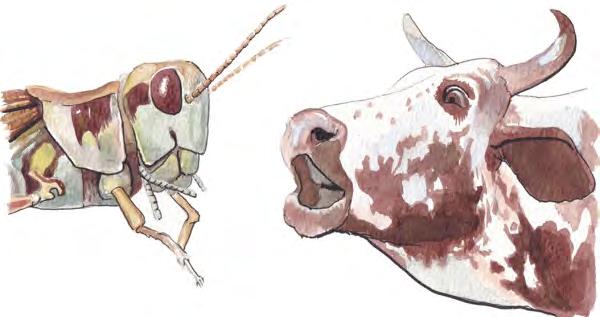
INSECT RECIPES
It’s important to prepare the insects properly before eating to rid them of inedible parts: For example, Cirina forda (the Pallid emperor moth or Shea defoliator) is degutted, while grasshoppers and termites are dewinged and de-legged. • Wash the insects • Boil, steam or fry them for at least five minutes (N.B. this is drypan frying or stir frying. Frying on its own is an unhealthy method that uses large quantities of oil) • Eat the prepared insects directly after cooking • If not eaten immediately, the insects must be preserved. Either keep them in a fridge or freezer, or sun-dry them to preserve them. They can last for a few days or several months if thoroughly dried.
In the tropics, insects are mainly harvested in the wild, so these steps are important. But some of these insects are now available in Western supermarkets. Here are a few recipes to get you started:
Termites (nemeneme in Venda, South Africa)
Termites are one of the tastiest forms of protein available on the planet. Termites are best toasted or lightly fried until they are slightly crisp. Since their body is rich in oil, very little or no additional oil is needed. Salt may be added for taste.
Soldier termites can be coaxed from their tunnels by probing their mounds with long reeds which they clamp onto.
They can be preserved by dry pan frying in salt until they are crispy. They can then be made into a stew with tomato, onion and whatever spices you like.
Flying termites are traditionally caught by placing pots of water under lights, which attract them.
Thief Ants (dinhlamakura)
These huge black ants only appear above ground once a year, just after the first rains, when they leave their nests to mate, reproduce and start new underground colonies.
Also called “big bottom” ants, they are prized for their rich taste. They can be eaten raw – their fat abdomens bitten off, discarding the head and legs. But they do very well as a fatty snack, like peanuts. For this, they should be lightly fried with salt.
House cricket
Grilled house cricket snack:
These insects are great with sesame oil. Remove wings and mix them with a few drops before putting them under an oven grill for about ten minutes, until they become crispy. Another preparation is to fry the wingless crickets in a few drops of sesame or olive oil for about ten minutes until crispy.
House crickets and dates:
The crickets can also be used to stuff dates - a beautiful contrast with the sweet date and nutty insect. Cut the dates open from the side, remove the pit, and fill with fresh or frozen crickets.
Caterpillars (Cirina forda)
These caterpillars can be collected from Burkea africana trees, which are found in most African countries.
When home, rinse with fresh water. Their innards (gut) need to be squeezed out – this is because they contain their food plant which is indigestible. Then boil them for 30 minutes in salted water. After boiling, spread them out on a tray and leave them in the sun. Allow them to bake in the sun for one or two days until crisp. If cooked over a fire they develop a distinct and tasty smoky flavour – like biltong.
INSECT RECIPES
They can then be eaten as a snack or prepared as a stew. To make the stew, fry them in oil with chilli and garlic. Add tomato, onion and capsicum and allow them to stew for 15 minutes. They go really well with rice or pap, a cornmeal porridge.
Long-Horned Grasshopper (Ruspolia spp)
These grasshoppers have long been part of the food culture in the Lake Victoria region of East Africa. They are most commonly green or brown. Collection is easy because the insects are attracted to light in the evenings.
Pull the wings off and eat them raw. But if you prefer to cook them, they can be either boiled or fried. Boiling is a preparation method used with large volumes of grasshopper where preservation is sought. Upon blanching, they are dried under the sun and preserved for future use.
Mopane worms
After harvesting the mopane worms (Imbrasia Belina), squeeze out their guts starting from the head. Wash the mopane worms in cold water and then boil them for about 15 minutes. Add salt to taste. Allow them to cool and put them out in the sun for a few days or smoke them until they are completely dry.
Dried mopane worms can be eaten as snacks with or without porridge or cooked again. To cook dried mopane worms; soak one cup of dried mopane worms in hot water for about 30 minutes. Rinse them in cold water. Put them in a pot with half a fried onion, 2 tomatoes, curry and green pepper. Add half a cup of water and a half teaspoon of soft salt, and mix. Boil for about 20 minutes.
Advantages of using insects as food
At a point in time where chemicals are abundantly used to propagate and preserve foods, edible insects present a clean alternative as they are free of hormones, home grown, organic and free range. Hence, they should be high on any health enthusiast’s diet list.
This article is republished from The Conversation under a Creative Commons license. Read the original article.
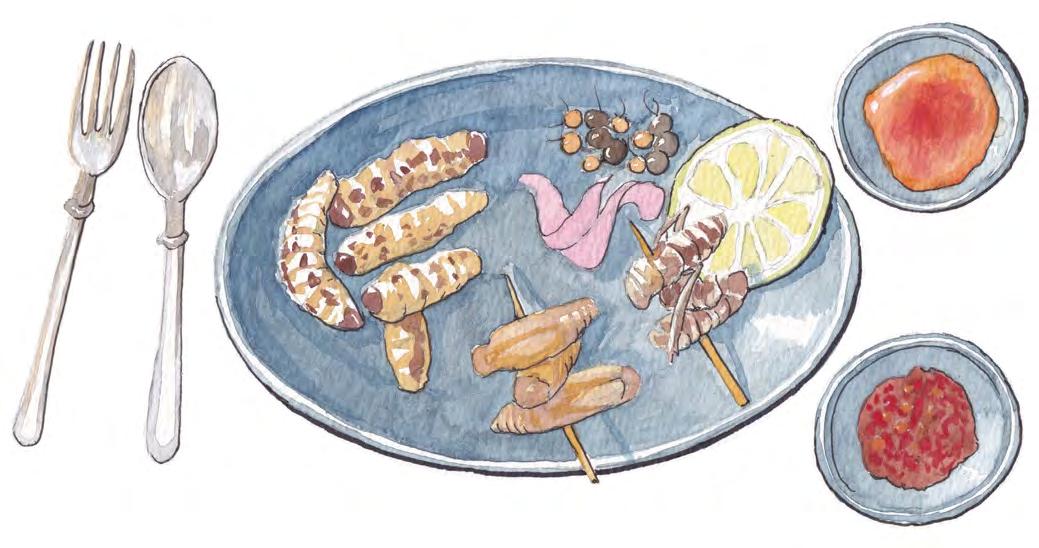
“Fanza, this is good research you have uncovered. Insects are more nutritious than meat but much better for the climate. And there are so many different ways to prepare them. I think the class will really enjoy this piece. Maybe we should cook a meal of insects for them!”
“Mmm, let me sleep on that, Abdou!”
“OK, what’s next on the menu, Fanza?”
“Fermented foods, Abdou! Dr Muniirah Mbabazi sent me this great piece on fermentation and what her grandmother used to do.”
Fermentation: for boosting nutrition and food
preservation (Something our grandmothers always knew!) by Dr. Muniirah Mbabazi
Fermentation has been used for millennia as a food preservation method and for flavour enhancement. It is ironic that lately in modern societies food experts are “discovering” what traditional communities have always known: that fermentation boosts the quality of food, offering all kinds of benefits and also enables a variety of ways for preserving food.
What is fermentation and what are its benefits?
Fermentation is a natural process through which microorganisms like yeast and bacteria convert carbohydrates — such as starch and sugar — into alcohol or acids. The alcohol or acids act as a natural preservative and give fermented foods a distinct zest and tartness. Fermentation also promotes the growth of beneficial bacteria, known as probiotics. Probiotics have been shown to improve immune function as well as digestive and heart health.
Communities have learned about the properties and uses of enzymes from their indigenous knowledge and for the porridge to cool to room temperature before sprinkling the sprout powder onto it and then leaving it to stand.
Malted porridge is consumed after two days or even after a month, and the alcoholic content increases with the duration of standing. In the first period, in the first two days of malting, even children like it because it is very sugary as the enzyme releases the sugar. After that, it becomes more of an adult food, because of the elevated alcohol content
A traditional African way of making fermented porridge
Bury
Grains Sprout Dry

Ferment
Grind
Store
Cook Cool 24 hours
Ferment 24 hours (longer for higher alcohol) Sprinkle
My grandmother’s traditional malted porridge
Where I come from, in Western Uganda, there is a famous malted porridge made out of millet or sorghum. My grandmother, like her neighbours, would harvest and clean the millet or sorghum, mix it with water, and then put it in the ground in a clean sack to allow it to sprout.
During the sprouting process, the process of mobilising enzymes that are later used for malting begins. The sprout is then dried and ground into a powder which may be kept for months or even years, for as long as it’s not in contact with water.
The traditional malted porridge is prepared by adding millet or sorghum paste to boiling water to prepare a porridge. When the porridge is ready to drink, it is left to cool to room temperature. Once cool enough the sprouted seed powder is stirred into the porridge, some water may be added, and the porridge is left to stand overnight. This process produces a non-alcoholic beverage.
In many households, it is common for the malted porridge to be consumed as a rehydration beverage and for rehydration therapy during illness when a high fluid intake, or energy revitalisation is required.
Other commonly fermented foods include cassava to make porridges and make a stiff bread. These are just a few of the ways that traditional cuisine enhances food through fermentation.

But how do we value and spread this local, indigenous knowledge?
“Abdou and Fanza, these are great pieces you have collected. How do you think this knowledge on insect harvesting and cooking practices and fermentation skills were passed on in rural communities from generation to generation?”
Fanza spoke. “I suppose by mothers and grandmothers. I remember as a child playing nearby and imitating the adults in our games. And then we would have to help prepare the vegetables and later even do some cooking.”
“But is this still happening?” Monica asked, looking at Abdou.
“Less and less, I suppose, as fast foods take over and tastes change. Though in some places people are returning to their roots, as we discovered.”
“Quite right, Abdou. But if we do not teach younger people and revive them in communities, the chances are high that in the next ten to twenty years many of these practices are going to be forgotten. Or we will sentimentally remember what we did “back in the old days” but carry on without as usual.
“So, the question we now face is what can we do to carry on these rich traditions of indigenous foods? How do we work with community groups that are keen to improve their own and their families’ health through eating better? This is what we are going to discuss when we get together next.”
NOTES
